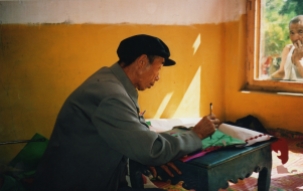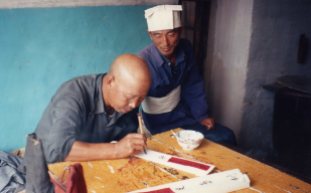
Among the numerous topics that have since amplified my blog, it’s always worth bearing in mind that its original raison d’être was to advertise my film Li Manshan: portrait of a folk Daoist (watch here!!!). It complements my book on the Li family, and numerous vignettes and updates on the blog (roundup here).
An initial round of screenings was followed by a lull during Covid, so I was happy to introduce it the other day for the Music Department of Bristol University, at the enterprising initiative of Michael Ellison, a composer with a strong focus on transcultural performance, in particular Turkish music (see e.g. here).
It was good to watch my film in company again. In my intro I observe that this kind of subject can’t be addressed only by reading old books in libraries: books are silent and immobile—fieldwork is the key! As I like to say, it’s not only about Daoism, it’s an everyday story of country folk—a bit like The Archers. So this isn’t some obscure academic subject, or some exotic remnant of ancient oriental wisdom—it evokes the basic concerns of local communities, and how they handle life and death.
Audiences will approach the film from different backgrounds: Daoist ritual (often with an emphasis on “salvage“), ethnomusicology, sinology, modern China, and so on. In my book (and on this blog) I try to show that all these strands have to be integrated. Students studying ethnomusicology (rather than “music”) will find it easier to grasp my comment that the film can’t be neatly pigeonholed under music; conversely, for students of Daoism (and even Daoist ritual) I stress that sound is the vehicle through which ritual texts are conveyed and animated; it should go without saying that soundscape must always be a major element in our study of ritual.
Watching the film again at a certain distance from my initial flurry of work, I worry that it may be somewhat tough going (Like, Hello?). For those eagerly awaiting the “red and fiery” bustle of ritual (Chau, Chapter 3), the opening sequence that sets the scene before we get to the funeral makes quite a lengthy prelude, and once the ritual begins the opening hymns (even abbreviated) are slow and a tad arcane for the uninitiated.
The pace gathers as we follow the sequence of funeral segments; the scenes with pop music, and the afternoon clowning, make suitable interludes; and viewers are reminded of the human personalities who have maintained the tradition through thick and thin, with vignettes on the great Li Qing (including his 1991 Pardon ritual) and the reminiscences of his widow being particularly moving. Li Manshan’s own voiceover is illuminating. So I still feel this is the way the film has to be…

Again, watching it at a certain remove, I recall with a certain amazement all the work involved in providing the translations for the vocal liturgy (with original texts shown on screen), and karaoke-style captions for the mnemonics illuminating the percussion patterns—culminating in the exhilarating Yellow Dragon Thrice Transforms Its Body, coda to the Transferring Offerings ritual (from 1.07.55). And I constantly admire Michele Banal’s fine editing.
While I point out that compared to some such groups in the south, the ritual practice of groups like the Li family band is quite simple, I still find it remarkable that they still do so much, even if it’s still a pale reflection of what they did 80 or even 20 years ago. Audiences tend to be interested in the future of the tradition, which I address in The life of the household Daoist. Other relevant posts from my roundup include
- Unpacking “Daoist music”
- Rectifying names
- Ritual change in north Shanxi
- A flawed funeral
- The Invitation ritual, a good illustration of the variety the Daoists need to master in rendering ancient texts (even a cappella with percussion, and even without the shengguan wind ensemble).
Anyway, DO watch the film (including the excellent joke after the end of the credits!), and spread the word!























